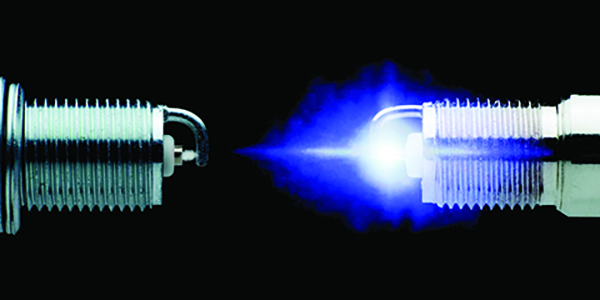Choosing a set of racing spark plugs for a particular application is not as easy as it sounds because the plugs have to be closely matched to the application. Stock plugs are fine for stock applications and ordinary driving conditions. But when an engine is modified to make more power and is run under racing conditions, a lot of things change inside the combustion chamber.
Two things are absolutely critical when it comes to choosing a set of spark plugs for a racing application: heat range and ignition reliability. Heat range is the most important because the wrong set of plugs can literally destroy an engine! Misfires won’t kill an engine, but they can certainly kill power and lose a race.
Heat range is a big deal with racing applications because modified engines produce more heat. They burn more air/fuel mixture with every combustion cycle so the plugs typically run hotter than in a stock engine. Because of this, the plugs have to be “colder” so they don’t overheat and become a source of pre-ignition and detonation.
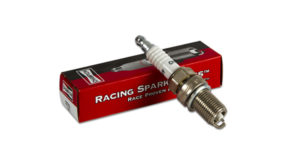
Heat Ranges
Spark plugs come in various heat ranges, which refers to the ability to conduct heat away from the tip so the plug doesn’t overheat. Reducing the core nose length of the ceramic insulator inside the plug shell can shorten the path heat has to follow to flow away from the tip of the plug. By varying the design of the ceramic insulator, a plug manufacturer can create a line of plugs that have different heat characteristics, from hot to “normal” to cold to really cold for all-out racing.
One spark plug manufacturer we interviewed said their heat range ratings run from 2 to 12, with 12 being the coldest rating. Most stock plugs are in the 4 or 5 range, while most racing plugs start with a 7 and go up from there. As with most plug manufacturers, the heat range is part of the part number on the plug.
Spark plug manufacturers make specific heat range recommendations for stock applications because they have tested the plugs in the engine and have validated the performance for fouling resistance and pre-ignition/detonation resistance. But most manufacturers will not make specific heat range recommendations for performance or racing applications because there are too many variables and they have no way to validate which heat range will work the best in a given application – and they don’t want to be liable for a blown engine if a recommended plug turns out to be too hot for the motor.
Determining the “right” heat range for a given engine is usually a process of trial-and-error for the average engine builder or racer. A spark plug manufacturer can use a specially modified spark plug equipped with a thermocouple to measure plug temperature during a dyno run. But lacking such equipment, the best you can do is do a dyno pull (or make a test run), shut the engine off without letting it idle, then remove and “read” the plugs to see if they are fouling.
If the ceramic insulator around the center electrode is covered with black soot deposits, the plugs are running too cold and you need to go one or two heat ranges warmer – unless the air/fuel mixture is running way too rich, in which case you’ll need to re-jet the carburetor to correct the A/F mix leaner. The best way to determine the A/F mix is with a wide band oxygen sensor in the exhaust. Peak power with gasoline is usually an A/F mix of 12.5 to 13.2, or 4.5 to 6.0 for methanol. If you’re running richer, you’re wasting fuel, hurting power and increasing the risk of plug fouling.
If the tips of the plugs have a yellowish or blistered appearance, they are running too hot and you need to go one or two heat ranges colder – unless the air/fuel mixture is running way too lean, in which case you need to re-jet the carburetor for more fuel.
You can always go too cold with a set of spark plugs and not damage your engine, but you can burn a piston if the plugs are too hot. The worst thing that will happen if the plugs are too cold is that one or more plugs may foul and misfire if the engine idles too long or is only run under a light load and never runs with the pedal to the metal.
Ideally, the tip of a spark plug should operate in the 600 to 725 degree F range. This is hot enough to prevent fouling and hot enough to allow for a consistent spark (a hot plug fires more easily than a cold plug). If the plug heats up into the 800 to 825 degrees F range, it can become a source of pre-ignition – which means the heat from the plug may spontaneously ignite the air/fuel mixture before the spark actually fires. Pre-ignition is bad news because it messes up combustion timing and quickly leads to detonation and engine damage. Consequently, the higher the heat load on the plug, the colder the plug should be to reduce the risk of pre-ignition and detonation.
Temperatures inside the combustion chambers of a Pro Stock drag motor can easily reach 1,700 to 1,800 degrees F 100 feet from the starting line, so it takes a fairly cold set of plugs to prevent overheating. In Top Fuel dragsters, operating conditions are even more severe. The combination of heat, vibration and pressure usually ruin a set of plugs after a single run. These motors typically use traditional J-gap plugs with modified ground electrodes. The end of the ground electrode is cut back slightly to expose more of the spark to the fuel mixture. The base of the ground electrode is also wider to improve strength so it doesn’t break off, which sometimes happens.
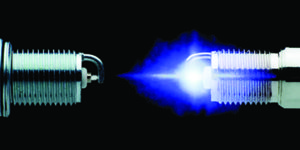
Spark Ignition
Each of the engine’s cylinders has at least one spark plug (and sometimes two) to initiate combustion. High voltage from an ignition coil flows to the center electrode of the spark plug, causing the plug to fire when the spark jumps the electrode gap at the end of the plug. The spark ignites the air/fuel mixture and produces a flame kernel that rapidly expands throughout the combustion chamber until all of the air/fuel mixture has been consumed.
Ignition occurs in one to two thousandths of a second. Once the spark jumps the gap, secondary voltage from the coil continues to sustain the spark until it can no longer keep the spark going. During this time, the plug will actually produce a series of sparks as high frequency oscillations in the coil continue to induce voltage spikes.
If you look at the secondary ignition pattern on an old fashioned analog ignition scope, the firing line will have a sharp high voltage spike (the initial spark and peak firing voltage), followed by a much lower “burn line” as the spark continues, followed by 4 or 5 wavy oscillations as the coil voltage fizzles out. The duration of the spark on an older distributor system will typically last about 1.5 to 2.5 milliseconds, and 1.0 to 2.0 milliseconds on a distributor-less electronic ignition system.
At 5,000 RPM, each spark plug fires 2,500 times per minute (42 times/second) second, which is well within the capabilities of a stock ignition system. But in a racing application, the engine may be revving as high as 8,500 to 10,000 RPM, or even higher in the case of a Formula 1 engine (an incredible 18,000 RPM). At these speeds, there is less and less time for the ignition coil(s) to build up voltage between plug firings. The time it takes a coil to reach peak voltage saturation is typically 3 to 5 milliseconds, which is still fast enough to provide reliable ignition at high RPMs – provided the coil can produce enough voltage in that time-frame to fire the plug.
The amount of voltage it takes to fire a spark plug depends on a number of variables: spark gap (the distance between the center electrode and ground electrode or electrodes if the plug has multiple ground electrodes); the amount of pressure inside the combustion chamber; the engine’s compression ratio; if the engine is naturally-aspirated or boosted; the type of fuel used (gasoline, ethanol, methanol or nitro methane); the air/fuel ratio (rich or lean); and whether the engine is using nitrous as a power adder or not.
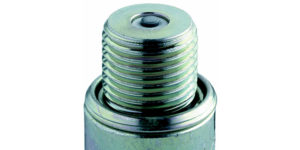
Jumping The Gap
Spark plugs come pre-gapped from the factory to cover a broad range of applications. However, the factory gap or even the recommended spark gap by the vehicle manufacturer may not be the ideal gap for the engine you are building. It will vary depending on the application.
The wider the spark gap, the more air/fuel mixture is exposed to the spark and the better the change of ignition when the plug fires. However, a wider gap also requires more voltage to jump the gap, which can lead to a misfire if the coil can’t provide the required voltage. Reducing the spark gap will reduce the firing voltage required to create a spark as well as the demand on the coil. However, if the gap is too narrow, there may not be enough air/fuel mixture between the electrodes to ignite reliably, resulting in a misfire and lost power.
Most spark plugs in late model vehicles have fairly wide gaps (.045 to .055˝) to promote reliable ignition, complete combustion, and low emissions. Most stock high energy ignition systems and coil-on-plug ignitions can provide sufficient voltage to keep the fire lit with these types of gaps, even when an engine is modified for more power (up to a point). But as cylinder pressures go up, so does the demand for higher and higher firing voltages.
Many circle track and drag cars run plugs with narrower gaps in the .020 to .035˝ range to reduce misfires. Some Pro Mod motors run gaps of only .014˝. Top Fuel dragsters and funny cars may run spark gaps as narrow as .010 to .013˝ because of the extreme conditions inside those combustion chambers.
One spark plug manufacturer said a good way to determine the ideal plug gap for an engine is to start out with a modest gap of around .035˝and gradually increase the gap several thousandths at a time until the engine starts to misfire and lose power (or run slower times). At that point you should reduce the gap several thousandths to achieve the best possible gap.
With a high output aftermarket ignition system, a typical street performance 383 Chevy stroker or big block Chevy can easily handle plug gaps in the .040 to .060˝ range for everyday driving.
Spark plug manufacturers use high-pressure test stands to simulate engine running conditions so they can evaluate spark plug performance under various operating conditions. From that, they can make a recommendation as to what spark gap should provide the best combination of ignition reliability and spark plug longevity.
A stock engine under light load may only require 8,000 to 10,000 volts to fire the plugs (depending on the plug gap). Under load, the same engine may require 15,000 to 25,000 volts or more to fire the plugs. This can be seen on an ignition scope as “Snap KV” (snapping open the throttle to see how much the firing voltage jumps as the engine accelerates). Snap KV will always be 3,000 volts or higher than the idle or light load firing voltage. Snap KV will also increase with plug gap and electrode wear, and may vary 2,000 to 4,000 volts as the engine is running. A greater variation in Snap KV would indicate something is changing the air/fuel mixture or is creating excessive turbulence inside the combustion chamber.
Some racing engines may need 30,000 to 40,000 volts or more for reliable ignition performance when the engine is running hard under load – especially if the engine is blown or turbocharged.
According to one manufacturer of high performance ignition systems, a rule of thumb for racing applications is to have at least 10,000 volts of secondary ignition voltage available for every .010˝ of spark plug gap. What’s more, the Snap KV that the engine requires under load should be no higher than 75 percent of the ignition system’s total coil output. If the ignition system lacks sufficient reserve voltage, the plugs may misfire under hard acceleration. You need a higher output coil.
The amount of amperage to the plugs is also critical for reliable ignition performance. A hotter coil that can produce a higher amperage spark will be less likely to misfire under load.
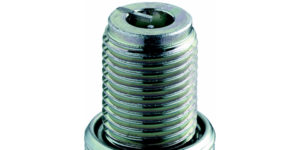
Electrode Configurations
A traditional J-gap plug is still the most common design for most stock and racing applications. On standard plugs for stock engine applications, the side electrode usually extends over the center electrode. This design shrouds the spark somewhat but also provides more surface to extend the life of the ground electrode.
An old racer’s trick that still works today on most standard J-gap plugs (not long life plugs) is to file back the tip of the side ground electrode until it is half way over the center electrode. This will open up the spark a bit for better flame propagation and reduce the firing voltage slightly by providing a sharp edge directly over the center electrode.
Center electrodes on both racing plugs and stock plugs may be a nickel iron alloy (standard plug), or tipped with platinum or iridium for wear resistance (long life 100K mile plugs). Multiple ground electrodes (2, 3 or 4) may also be used to reduce electrode wear for longer plug life. Spark plugs with more than one ground electrode do not generate multiple sparks because the plug only fires once per ignition cycle. The multiple electrodes merely provide multiple surfaces the spark can jump across to reduce the wear on any given electrode.
Electrode wear slowly widens the gap between the electrodes on all spark plugs, which slowly increases the voltage required to fire the plug. Eventually the point is reached when the gap becomes so wide that the spark never forms causing the plug to misfire. Plug wear is a concern in stock applications, but is generally not an issue with racing plugs because the plugs are changed frequently and don’t have to go 100,000 miles between changes.
Platinum and iridium plugs are highly wear resistant and can usually go 100,000 to 120,000 miles in most stock applications – assuming the engine isn’t burning oil due to a ring sealing or valve guide wear problem. Platinum and iridium are both very expensive metals, so they are only used on the very tip of the center electrode. Platinum may be used as a small button welded onto the end of the center electrode (and the side ground electrode in “double-platinum” plugs), or it may be used as a fine wire tip as is the case with most iridium plugs. A small diameter fine wire tip for the center electrode helps concentrate the spark and reduce misfires. Many racing plugs have fine wire iridium tips because of the spark advantages and wear resistance provided by iridium.
Another metal that is used for the tip of the center electrode in some racing plugs is silver. Silver conducts electricity three times better than iridium, and six times better than platinum. This helps to increase the current across the electrodes when the plugs fire for a more reliable spark. The drawback with silver is its low melting point and lack of wear resistance compared to iridium or platinum. Silver plugs will only last about 20,000 to 30,000 miles in a motor.
Surface gap plugs that do not use a conventional J-gap side electrode or multiple electrodes are also common in some forms of racing. The business end of a surface gap plug can be very compact, which makes it well suited for tight combustion chambers with domed pistons. There’s no side electrode that protrudes above the tip of the plug. The absence of a side electrode also means there’s no electrode to melt or break off in a high revving engine. Formula 1 and NASCAR have both used surface gap plugs for this reason.
A surface gap plug fires sideways. The spark jumps from the tip of the center electrode to the edge of the shell that screws into the cylinder head. The spark gap is much wider than a typical J-gap plug (up to 3 mm) so a surface gap plug requires much higher firing voltages and a high performance ignition system that can generate a lot of juice.
Some side gap plugs do have a small ground electrode that sticks out from the side to decrease the spark gap, while others have a series of notches cut into the end of the ground shell to create a tooth-like edge. This helps to reduce firing voltage requirements and misfires because sparks jump more easily to a sharp edge than a smooth or rounded edge.
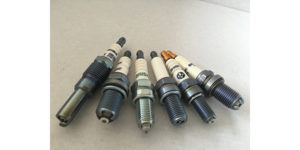
The Diesel Difference
Diesel engines don’t use spark plugs for ignition but rely instead on the heat of compression to initiate combustion. Fuel is injected directly into the combustion chamber under high pressure just as the piston approaches top dead center. Residual heat in the combustion chamber from the last power stroke combined with the heat generated by compression ignites the fuel.
The only problem with this approach is cold starting a diesel engine. At low ambient temperatures, compression alone may not generate enough heat to light the fire. So additional heat may be needed to get the fire going. The initial start-up heat is provided by a set of glow plugs.
Glow plugs resemble spark plugs except without an electrode gap and no spark. They are essentially resistors that glow red-hot when high amperage current is passed through the plug. A timer circuit preheats the glow plugs before the engine is cranked, and then turns the plugs off after a preset time when the extra heat is no longer needed. Some engines may also turn the glow plugs back on momentarily if the engine has been idling for an extended period of time to reduce the risk of misfires.
Glow plugs won’t foul out like spark plugs, but they can burn out. A couple of bad glow plugs can make a diesel engine harder to start when temperatures drop, but will otherwise have no affect on engine performance. A bad glow plug control module or relay, on the other hand, can render the whole system inoperative. This may make some diesel engines nearly impossible to start in really cold weather. Glow plugs can be checked with an ohmmeter to make sure they are in specifications. If a plug reads open or has excessive resistance, it has failed and needs to be replaced.

